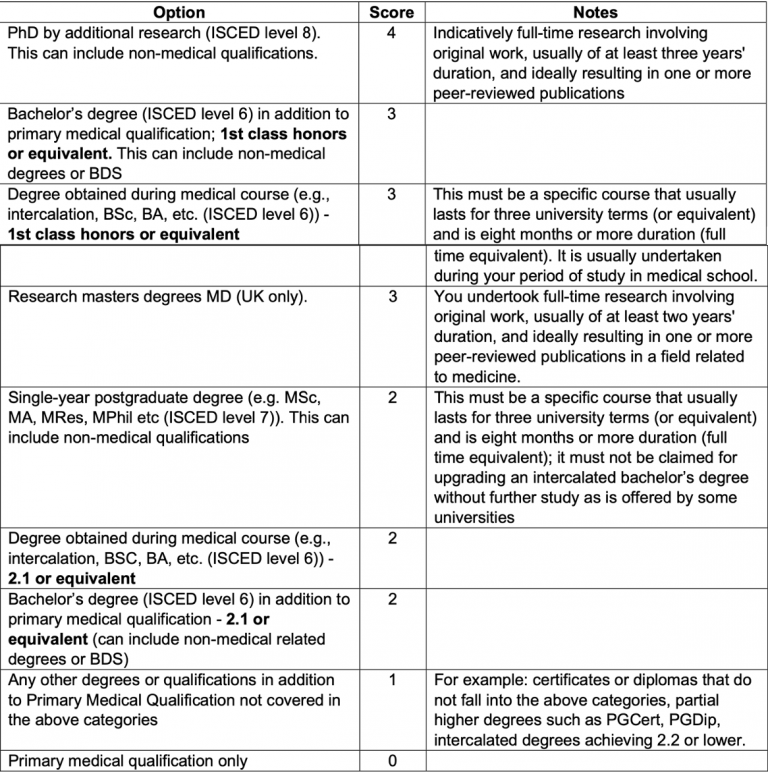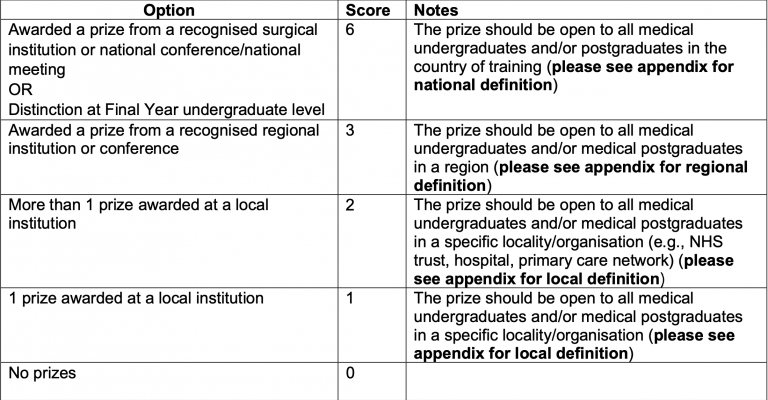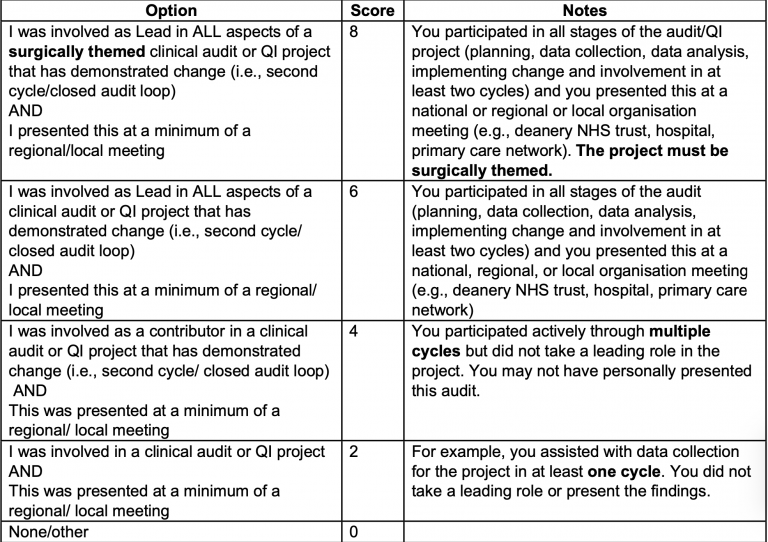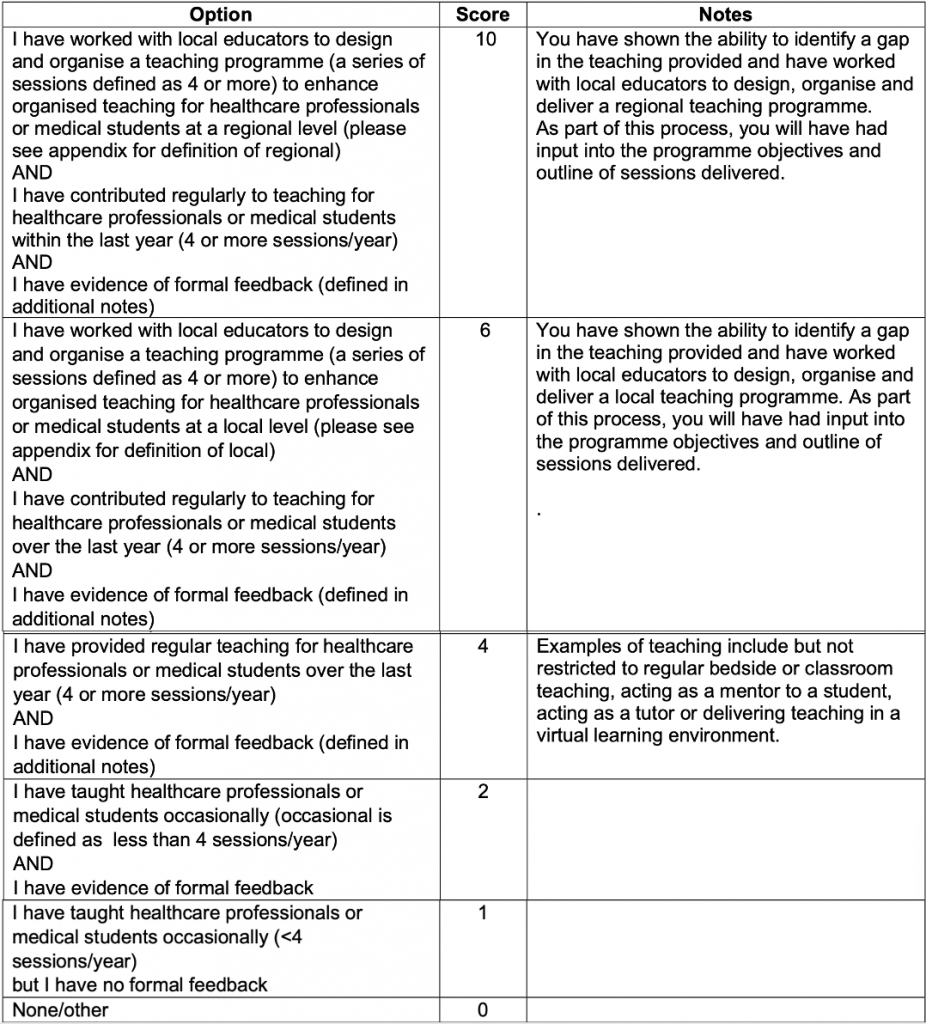Introduction
The portfolio part of your core surgical training application is the only bit you can start preparing during medical school. Out of 2500 who applied, only 1100 got an interview in 2020. So it is essential to understand the requirements and start preparing your portfolio throughout your medical school career.
Section 1: Commitment to speciality
This section has a combined score of 20, more than any other section of your portfolio. This part is easy to build up over time but tough to do in a short space of time.
MRCS Part A

MRCS Part A is the first of two surgical exams, which you need to pass before you apply to become an ST3 in a surgical speciality. Read James’s article for more info on this (Found Here). Previously, booking part A was enough to get you one point. But this has changed this year, meaning you only get points if you have passed it.
Tips:
The two things you need to think about before signing up to take this exam are time and money. You can take it as soon as you become an FY1 doctor. But remember that if you take this exam during the foundation years, you are not entitled to getting study leave to revise for it (whereas you are during core surgical training). Using your precious annual leave to revise is no fun, and the last thing you want is to fail and have to retake, using more money and annual leave. So I advise you not to sign up to do this exam unless you have time to revise. I recommend doing it in a rotation with no or little out of hours commitments, like GP.
Surgical Courses

Not all courses count! Look out for the following criteria:
– Surgically themed
– Organised by UK Royal Colleges of Surgeons,
– Organised by National surgical organisations such as ASIT
– Organised by Regional deanery.
– Or a course with CPD accreditation
Please note that local surgical courses organised by hospitals or undergraduate medical school societies do not count. But remember, this constantly changes and do not rule out local courses for this reason.
Tips:
Try to find a free course if you can. In your second foundation year, you will get a study budget. In 2020-21 was around £400 in Severn. But this varies between deaneries and trusts, so you need to ask about it. Don’t worry about paying for super expensive courses. During your core surgical training, you will have a bigger study budget for costly courses such as advanced life support (ATLS). Another way of getting these courses is through membership of surgical organisations such as ASiT. You will have to pay an annual fee, but you get many courses through this.
Examples of courses:
– Urology National Catheter Education Programme – online, free and very informative (found here)
– Basic Surgical Skills Course, two days, expensive (around £600), but very useful and practical
– Courses organised by ASiT (surgical radiology, preparing for a career in surgery, foundation surgical skills)
Operative Experience

Please note that you will need to have assisted or performed for each of these cases to count. There is no specific requirement for having a range of specialities or procedures, but in theory, it is better to have a range.
You need to keep evidence of your experience in a logbook. Currently, the only acceptable logbook is the free surgical elogbook (found here) that you can make an account for! Please note that procedures that are part of foundation programme competencies do not contribute to this (e.g. Catheterisation).
Tips:
Start your surgical logbook as soon as you start attending theatre at medical school. In the beginning, you might start by just observing operations. But the more you go, the more you will be allowed to do. The operations you assist with as a medical student count, so definitely record them. Assisting could be as simple as being scrubbed in and holding instruments in place.
Surgical Conferences

Similar to courses, not all conferences count! Look out for the following criteria:
– Surgically themed
– Organised by UK Royal Colleges of Surgeons
– Organised by International/National surgical organisations such as ASIT
– Organised by Regional deanery.
– Or a conference with CPD accreditation
Tips:
Try to present a poster whenever you attend conferences (read more on the presentation section). Surgical organisations put up conferences all the time. We’ll be highlighting the upcoming conferences on this website and our social media accounts.
Surgical Experience

This section of the portfolio has created much controversy. The majority of the candidates applying for a CST job would have completed foundation year training, as a part of which you would complete a surgical rotation, getting you the maximum points. This change was partly done as a result of the cancellation of medical electives due to the pandemic. We expect this will change in the future.
Tips:
If you haven’t done a surgical rotation or elective for some reason, make sure you organise five taster days in surgery. They don’t have to be consecutive, meaning you could do them one day at a time and still get the maximum points.
Section 2: Post-Graduate Qualification

This section is relatively self-explanatory. Many factors will influence your decision of intercalating. Check out Daniel’s article for more info. But it is worth noting that you will also get points for ST3 applications for additional degrees. Compared to all the other sections, this part of the portfolio requires the most time and money. So you should not do this to get a few additional points.
Section 3: Prizes/Awards

This is the only part that you will get rewarded for doing well in your medical school exams. 6 points out of 72! This is why you should also focus on other parts of your portfolio.
Tips:
If you did not get a distinction on your primary degree, this part could be very challenging to get. My advice is that the best way of going for this is by taking part in as many poster/oral presentation competitions at conferences as possible. Another way of achieving this is by looking for essay competitions that different national organisations regularly put on. Note that the award/prize does not have to be surgically themed.
Section 4: Quality Improvement/Clinical Audit

The goalposts for this section of the portfolio change every year. Last year, to get the max points, you needed a QIP in any field presented nationally. This year, the QIP has to be surgically themed and presented locally.
Tips:
A closed audit loop or second cycle is crucial to get these points. Whatever your project was, you need to check something at the beginning, implement an intervention, and re-check the results of your intervention to ensure it has improved things. You will only get 2 points if you do the audit once.
Section 5: Teaching Experience

There is a lot of focus on teaching experience this year, and this section gets you the second most number of points in your portfolio. Again, the goalposts have changed this year. Previously, you needed three months of teaching regionally or nationally to score the maximum points in this section.
Tips:
An easy way of going about this is to organise online teaching across different hospitals in your deanery. It could be as a foundation doctor teaching medical students. You could do a general finals revision course. Make sure you do a pre and post-course survey, and you could use this data to present at an educational conference.
Several factors are important to consider here. You need to satisfy all three criteria to get the max points:
– Designing a regional course and delivering at least four sessions of it.
– Over the last year, regularly contributed to teaching (4 or more sessions)
– Formal feedback reviewed by a consultant.
You will need a letter from a consultant saying they have reviewed your feedback and you have delivered good quality teaching for the formal feedback. Alternatively, you could collect, analyse the feedback and present it at a conference as an abstract/poster.
Section 6: Training in Teaching

Tips:
Similar to the post-graduate qualification section, this section is highly time-consuming and expensive to score highly in. There are a lot of F3 year jobs that offer to fund a PG Cert in medical education. However, do not underestimate how much time you will need to complete these courses. The one provided by the University of Bristol requires you to complete two 3000 word essays and a narrated PowerPoint presentation, all of which take a long time. Moreover, if you are completing this during your F3 year, the odds are that you will not complete it before the application deadline. My advice to foundation doctors applying is to do an online course, organised by your deanery. Severn foundation school puts up some free courses over the year.
Section 7: Poster or Oral Presentation

Tips:
The options to score the higher points are either two national poster presentations or one national oral presentation. This could be at a virtual conference. As mentioned earlier, I advise you to submit an abstract every time you attend a conference. This could be from a student choice project report, an audit, intercalation report or else. It is always worth trying as you tend to underestimate the value of your work. Most conferences will give you the option of submitting a project for consideration for both oral and poster presentations. Always tick both boxes! Even if you have done a national oral presentation, carry on submitting abstracts for posters in the future. You might win a prize.
Section 8: Publication

Tips:
Publications have always been a requirement for surgical applications. Collaborative projects are easier to get involved with, especially as a student. Otherwise, you can ask the consultants or registrars on the wards whether there are any projects you could get involved with potential for publication. Always clarify whether you will be a named author on the projects or not at the beginning of your involvement. Previously, you were required to provide the PubMed ID, which was enough to prove your publication. This year, they need you to have a letter from the publisher, including the title, your name and date of publication. So if you get anything published now, email the journal for this letter straight away. It is easier to do this straight after publishing as opposed to a few years later.
Section 9: Leadership

Tips:
This is perhaps one of the most straightforward domains of your portfolio, and you could approach this in a methodical manner. Start by applying for local roles within your university or hospital and slowly build up your leadership experience. The more leadership experience you have, the better your chances of getting national positions. Two things to remember here, you will need to have been in post for six months by the time of your application deadline (1st of December) to be able to claim this. Secondly, you will need to show evidence of positive impact. This could be from a consultant or another member of the organisation writing a supporting statement.
Frequently asked questions
What evidence is acceptable?
As a student, I did a lot of extra-curricular activities. Not to build my CV but because I was interested in them. I collected whatever evidence I was given for these activities. For example, I taught basic life support to first and second-year medics and have a certificate saying I did this. But this is not enough! I should have gotten a certificate that I delivered this teaching, how many times, over how long, and if anyone observed me or provided me with feedback. It is easy to ask for a certificate with the exact wording immediately after doing the said activity. But it is a lot harder to go and chase the consultants a few years afterwards.
Most sections of the portfolio require a letter by a consultant with their GMC number and signature on an officially headed letter. If it is a conference you presented at, it will need the headed certificate saying you presented. Check the official 2022 PDF for the acceptable evidence you need for each section.
What is the best way of getting the correct wording on the certificate?
I found emailing consultants with a drafted word document with the exact wording written in the latest copy of the portfolio pdf. Please give them the option of changing the wording in whatever way they see fit. But by pre-writing the bulk of it, it allows them to quickly skim through it and sign it if there are no mistakes and include all the details you need.
What score do you need to get an interview
This varies from year to year. In 2020, you needed a minimum score of 48. But remember, it all depends on how many people would be applying, and 2020 was the highest competition ratio so far.
Do I need to aim to max out all the different parts of the portfolio?
No is the short answer. Aim to maximise the points in sections such as QI project, commitment to speciality and teaching experience. This will let you some flexibility in hard to get areas such as post-graduate degrees, Training in teaching and awards. It’s all about getting the balance right.
How to use this guide?
Although the themes underlying the portfolio requirements have stayed the same (e.g. teaching experience or leadership experience, etc.), the goalposts have moved every year. Therefore, use this as a guide to work on different sections of your CV. Each year, the requirements get released a month before the application deadline, meaning there is not enough time to react to these changes. For example, to get the maximum points in the quality improvement section in 2020, you had to design and run a QIP in any field and present it at a national meeting. However, in 2021, you have to do a QI project in a surgically themed speciality to get the maximum points. The more experience you gain over the years, the more likely you are to have built a portfolio that is high scoring despite the changes in the goalposts.
What is the application process for CST?
Read the previous article with all the steps here.
Final words and full PDF
I hope this clarifies some of the questions you might have about surgical applications. Follow us on Instagram or Twitter (@medprojecthub) for more information.
Download the full official PDF here.


